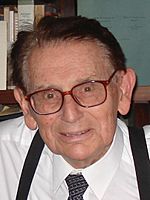Marcos Moshinsky facts for kids
Quick facts for kids
Marcos Moshinsky
|
|
|---|---|
 |
|
| Born | April 20, 1921 |
| Died | 1 April 2009 (aged 87) |
| Nationality | Mexican |
| Alma mater | National Autonomous University of Mexico, Princeton University. |
| Known for | Transformation parenthesis for harmonic oscillator functions |
| Awards | Prince of Asturias Award for Scientific and Technical Investigation (1988) UNESCO Science Prize (1997) Wigner Medal (1998) |
| Scientific career | |
| Fields | Elementary particles |
| Institutions | National Autonomous University of Mexico |
| Doctoral advisor | Eugene Paul Wigner |
Marcos Moshinsky Borodiansky (Russian: Маркос Мошинский Бородянский; Ukrainian: Маркос Мошинскі; 1921–2009) was a famous Mexican physicist. He was originally from Ukraine and had Jewish heritage. His amazing work in the field of elementary particles earned him important awards. These included the Prince of Asturias Prize for Scientific and Technical Investigation in 1988 and the UNESCO Science Prize in 1997.
Early Life and Education
Marcos Moshinsky was born in 1921 in Kyiv, which was then part of the Ukrainian SSR. When he was just three years old, his family moved to Mexico as refugees. He became a Mexican citizen in 1942.
He studied physics at the National Autonomous University of Mexico (UNAM). Later, he earned his doctorate degree in physics from Princeton University. His teacher there was Eugene Paul Wigner, who later won the Nobel Prize in Physics.
Scientific Discoveries and Career
In the 1950s, Marcos Moshinsky studied how nuclear reactions happen and what makes up the inside of an atomic nucleus. He came up with a new idea called the transformation bracket for eigenstates of the quantum harmonic oscillator. This idea, along with special tables he made with Thomas A. Brody, made it much easier to do calculations in the nuclear shell model. This model helps scientists understand the structure of the nucleus. His work became a very important tool for studying atoms.
In 1952, he also made another big discovery. He studied how matter waves move over time, which led to the finding of something called diffraction in time.
After finishing more studies in Paris, France, he came back to Mexico City. There, he became a professor at the UNAM. He was chosen to be the president of the Mexican Society of Physics in 1967. In 1972, he became a member of the National College, a group of Mexico's most important scientists and artists.
Marcos Moshinsky was also an editor for many science magazines around the world, like the Bulletin of the Atomic Scientists. He wrote four books and over 200 scientific papers. He received many awards for his work, including:
- The Mexican National Prize for Science (1968)
- The Luis Elizondo Prize (1971)
- The Prince of Asturias Prize for Scientific and Technical Investigation (1988)
- The UNESCO Science Prize (1997)
In 1990, he was made a Fellow of the American Physical Society. This was because of his many important contributions to understanding how groups of tiny particles behave using special math techniques.
Beyond Science
Even though he was a busy physicist, Marcos Moshinsky also wrote a weekly column for the newspaper Excélsior. In these columns, he shared his thoughts on Mexican politics.
See also

- In Spanish: Marcos Moshinsky para niños

